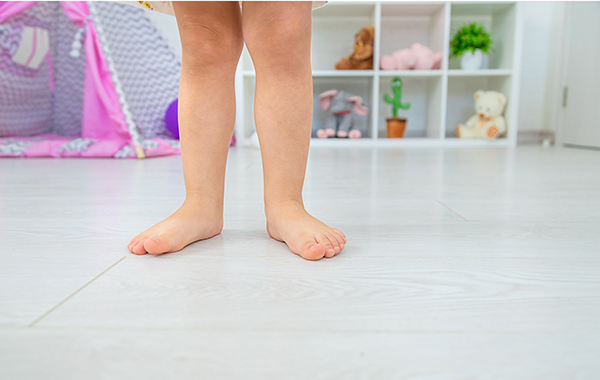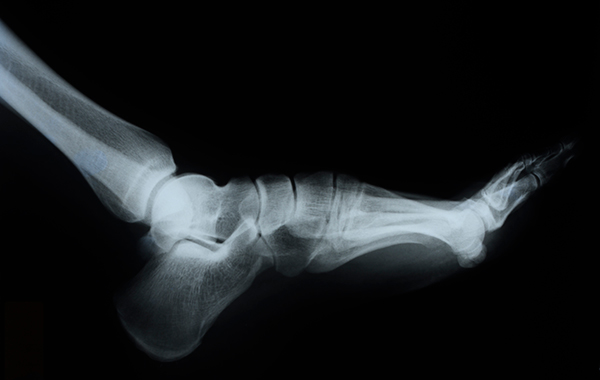What is Paediatric Drop Foot?
Foot drop is a musculoskeletal disorder that affects the lower limb. It is characterised by weakness in the ankles or an inability to flex the ankle joint. Foot drop can be bilateral (both sides) or unilateral (one side) and can be permanent or temporary depending on the cause. This condition can be resolved early through podiatric intervention.
UNDERSTANDING PAEDIATRIC DROP FOOT
Overview
The causes of foot drop can vary in terms of severity and permanence. In most cases, the appearance of this condition can usually be attributed to a neurodegenerative disorder that occurred in childbirth or during the early days of life.

Cerebral palsy (CP)
This neurological condition causes motor and movement disabilities and can vary in levels of severity. Although it is the most common motor neurone disorder in children, it tends to affect more boys than girls. This condition can be:
Congenital:
Abnormal brain development or damage to the developing brain occurs during pregnancy because of birth defects such as being too small or premature, being a twin, or other complications.
Acquired:
Brain damage occurs after the first 28 days of life, usually due to an infection or head injury.
Paediatric stroke

This neurological condition causes motor and movement disabilities and can vary in levels of severity. Although it is the most common motor neurone disorder in children, it tends to affect more boys than girls. This condition can be:
Strokes in children can happen suddenly and are typically caused by an injury to a blood vessel in the brain, leading to injury in the surrounding brain tissue. Strokes can be categorised into two forms; acute trauma causing bleeding into the brain (haemorrhagic), or an insufficient supply of blood due to a blockage (ischemic).
Common symptoms include weakness or diminished movement on one side of the body and decreased muscle tone in infants. These can also appear as trouble with balancing and walking or sudden lethargy. Paediatric strokes are considered rare and are often misdiagnosed or undiagnosed.
Spina bifida
Spina bifida is a condition that affects the spine due to a neural tube defect. One such condition, known as myelomeningocele, is the most serious type of spina bifida and occurs when the spinal cord and canal do not form or fail to close. A particular physical characteristic of this condition is a protruding sac of fluid from the child’s back. This growth traps and damages part of the spinal cord and nerves, causing moderate to severe disabilities. These may include a loss of feeling, a lack of function in the lower limbs, and a high incidence of foot deformities. Spina bifida is usually diagnosed intrauterine through prenatal testing or after the baby is born.
Early signs of foot drop in babies include:
Weakness or an inability to flex the foot and ankle
No resistance when changing
Foot drop can be very difficult to identify especially with babies and young toddlers who haven’t started to walk. Their movements should be monitored closely.
Foot drop can be easier to identify in older toddlers and children as the symptoms are more noticeable. Some common symptoms include:
Bending the knee more than normal during motion to help with ground clearance of the foot (steppage gait)
Hiking the hip higher on one side
Inability to lift the toes or forefoot
Limping
Decreased muscle strength
How Can Podiatry Help My Child’s Foot Drop?
Your child’s developmental history, birth complications, medical history, and milestones will be thoroughly assessed during the initial consultation to determine the diagnosis and its severity. If your child’s deformity is severe, prompt intervention must be taken to rectify and increase the efficiency of their gait.
Depending on the type of foot drop, your podiatrist may recommend the following:
Fitting your child with rigid/dynamic braces, splints, and/or orthotics to assist in movement
Stretching exercises
Using therapy to improve muscular function and provide nerve stimulation
Regular follow-ups to assist with the guided development and growth of your child
Tailored advice and education on the diagnosis

Podiatrists at Nofrills Podiatry are highly experienced in handling complex paediatric cases. Parents who suspect the presence of foot drop in their children should seek a podiatrist’s professional opinion as soon as possible.
What are the Common Causes?
Inability to flex the foot and ankle
Limping
Inability to lift the toes or forefoot
Book your initial podiatry visit
hello@nofrillspodiatry.com
Phone
9007 1085
Open Hours
Mondays - Sundays: 9am-6pm
We're Here Whenever You Need Us
hello@nofrillspodiatry.com
Contact Us
9007 1085
Open Hours
Monday-Sundays: 10am to 7pm
Address
About
About Us
Symptoms We Help With
FAQs
Careers
Contact Us